Roasted Chestnuts signal the start of the holiday season. This easy recipe is a family favorite, perfect for Christmas time. Roasted Italian chestnuts, called Caldarroste, have a crispy exterior and tender interior, a festive treat you won't want to miss. Look for them at your local grocery stores or farmers' markets from early October to late December to make these oven-roasted chestnuts for the whole family to enjoy.
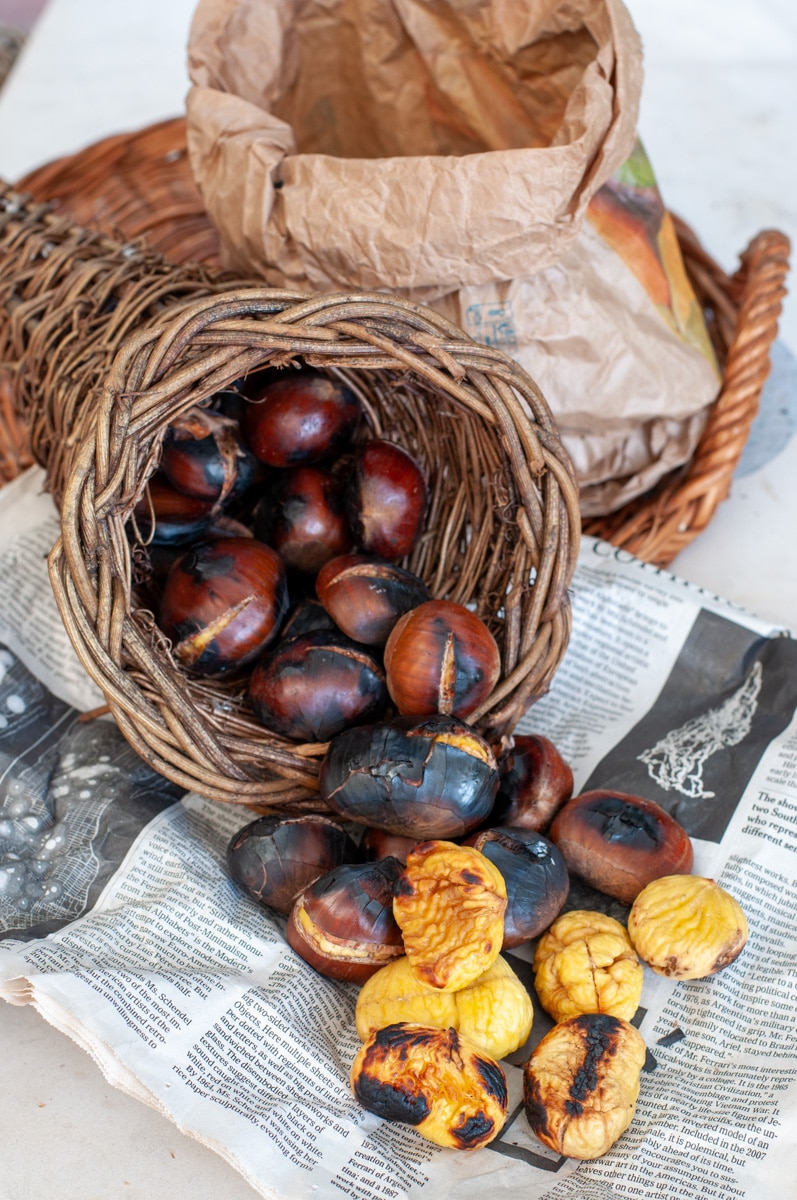
Jump to:
- Roasting Chestnut like a street vendor
- Types of Chestnuts
- Special equipment
- Preparing the chestnuts
- Roasting chestnuts on a fire or grill
- Roasting chestnuts in the oven
- How to serve them
- How to peel them
- How to eat them
- How to store them
- More recipes with chestnuts
- More recipes on an open fire
- 📋Roasted Chestnuts On an Open Fire or Kitchen Oven
Roasting Chestnut like a street vendor
Strolling through Rome, like in many European cities, during the Christmas season you'll often stumble upon street vendors roasting chestnuts in a little oven.
The best-roasted chestnuts I had were on the street corner of the Piazza Navona Christmas market, with Christmas music playing from the nativity set of Sant'Agnese in Agone Church.
They serve up those piping hot chestnuts bundled in a newspaper cone, and just clutching that warm bundle is like a little piece of heaven for your chilly hands.
The aroma of those roasting chestnuts hits you right away, making your mouth water in anticipation.
When you finally sink your teeth into one, it's a burst of warmth and that delightful nutty, biscuity flavor – absolutely delicious.
But here's the twist: Not all chestnuts are created equal. Sadly, most of them tend to have unwanted guests, like little worms.
So, out of every 10 chestnuts, you're doing pretty well if you get to enjoy 3 or 4.
Still, despite the odds, it's an experience worth every penny!
To improve the success rate, I learned to roast them at home, just like a street vendor.
For us Italians, chestnuts are more than just a snack; they're a part of our lives.
Trust me, we've got the chestnut roasting game down to a science, and this is how we roast them.
For more chestnut recipes, you can find: Chestnut pavlova, Mont Blanc dessert, Chestnut Gnocchi, sausage stuffing with chestnuts, tenderloin stuffed with chestnuts
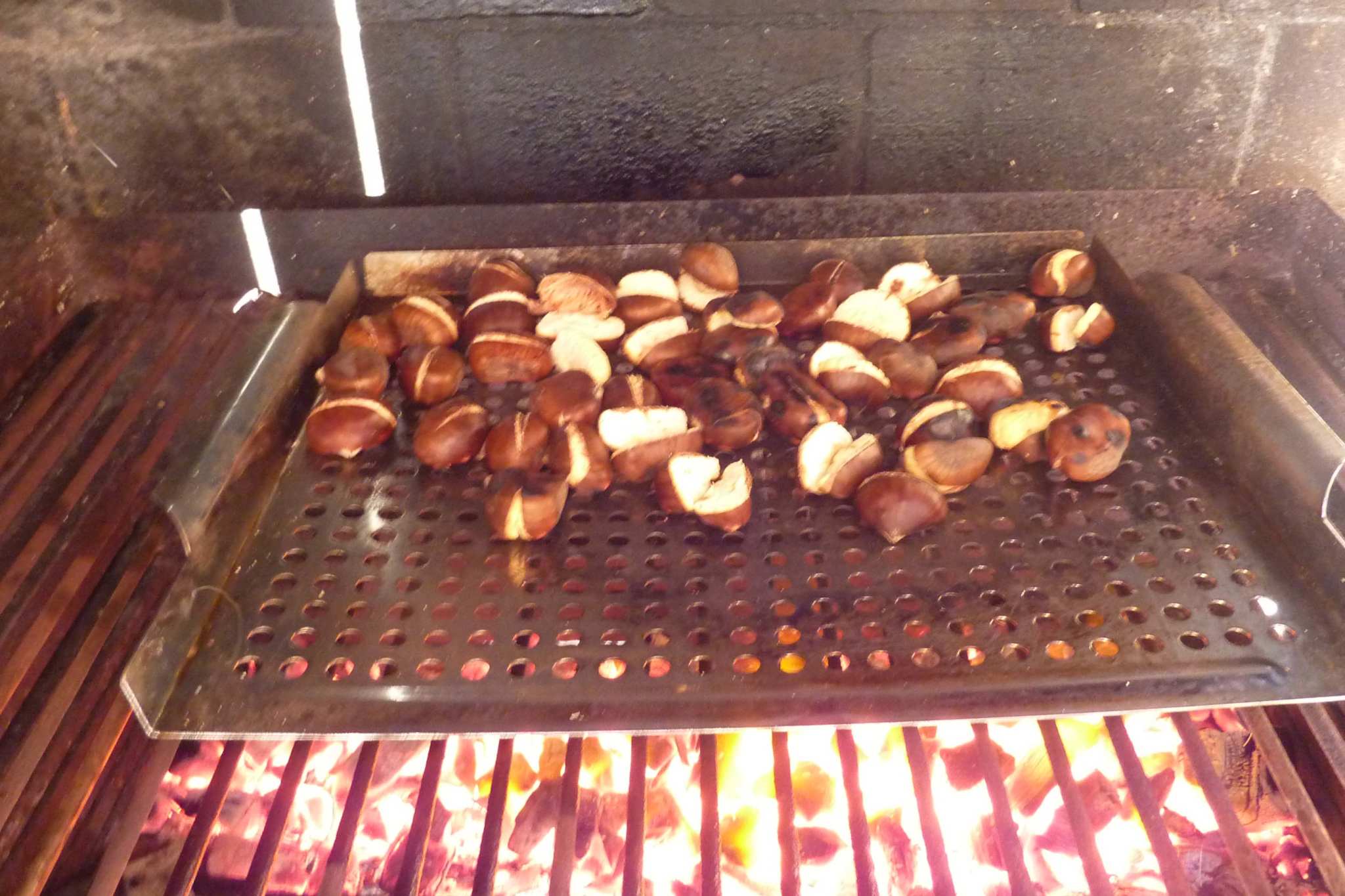
Types of Chestnuts
When I was young, we used to pick up our chestnuts in a woodland near the Roman Castles.
Chestnut season offers a bounty from the various chestnut trees.
Fresh chestnuts come encased in a hard shell, protecting the chestnut kernels and have a meaty texture beneath their papery skin.
You do not need any other ingredients to roast chestnuts.
However, you may want to look for Marron in French or Marroni in Italian, that are a premium variety known for their larger size and distinct flavor.
Marron chestnuts are used to make Marron Glacé, a luxurious treat that elevates the humble chestnut to gourmet status.
They are caramelized and sugar-coated chestnuts often enjoyed during special occasions or as a refined dessert.
Identifying edible chestnuts from horse chestnuts is crucial for safe foraging and cooking.
Horse chestnuts are inedible, so knowing the difference is essential.
- Edible chestnuts have a pointed, tassel-like tip and are encased in a spiky, green burr.
- Their shells are relatively thin and easy to cut through; they have a rounded side and a flat side.
Instead:
- On the other hand, horse chestnuts have a rounded, smooth appearance with no tassel and are encased in a burr with fewer, more widely spaced spikes.
- Their shells are much harder and glossier.
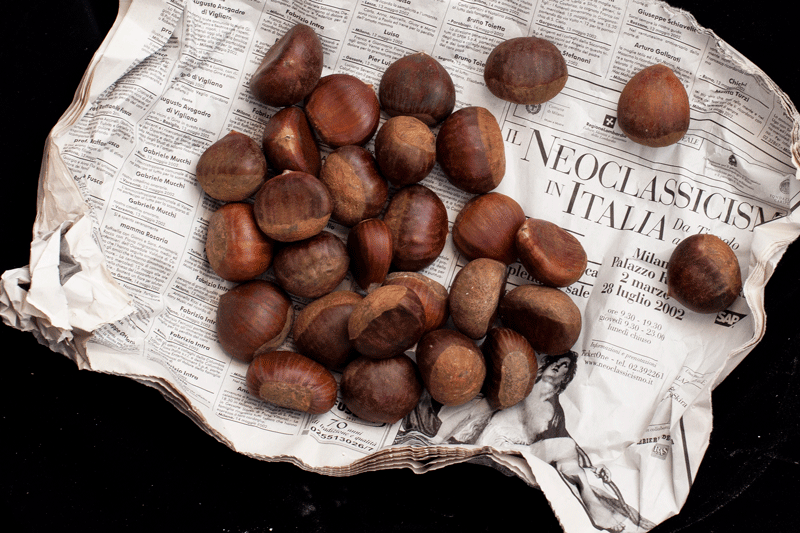
Special equipment
To roast chestnuts on an open fire or grill, you'll need the following equipment:
- Fire-Resistant Gloves: To protect your hands from the heat.
- Long-Handled Tongs: For turning and retrieving the chestnuts.
- Chestnut Roasting Pan or Grill Basket: A specialized pan with holes, or a grill basket to hold the chestnuts.
- Roasting tin: if you plan to roast them in your kitchen oven
- Sharp serrated knife: or a chestnut knife to score the chestnuts before roasting.
- Fire Poker: To adjust logs or charcoal, ensuring an even heat.
- Aluminum Foil: Optional, for wrapping chestnuts if you prefer them steamed rather than roasted.
- Serving Bowl: To hold the roasted chestnuts once they're done.
With these tools in hand, you'll be well-prepared to roast chestnuts like a pro!
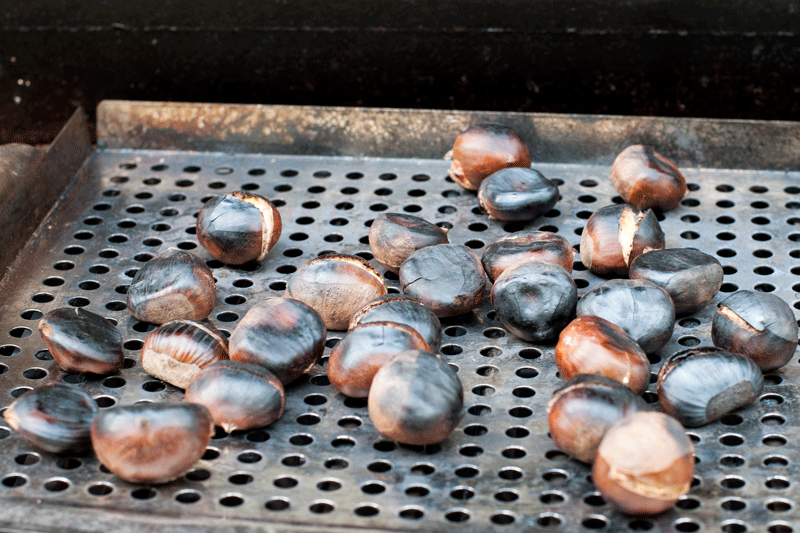
Preparing the chestnuts
Selecting the chestnuts
Preparing raw chestnuts for roasting starts with separating the good chestnuts from the bad.
Look for hard chestnuts that are heavy for their size and free of cracks or holes.
Bad chestnuts are often lighter and may have a rattling sound when shaken, indicating that the meat of the chestnut has shrunk.
Scoring the chestnuts
Once you've sorted the good from the bad, it's time to score them.
- Place a chestnut on a cutting board with the flat side down and the round side facing up.
- Using a sharp paring knife, carefully cut a long slit into the outer shell of the chestnut.
- Make sure to score the shell and only slightly through to the meat of the chestnut.
- A shallow cut across the round side of each chestnut is sufficient.
Scored chestnuts allow steam to escape and make peeling easier after roasting.
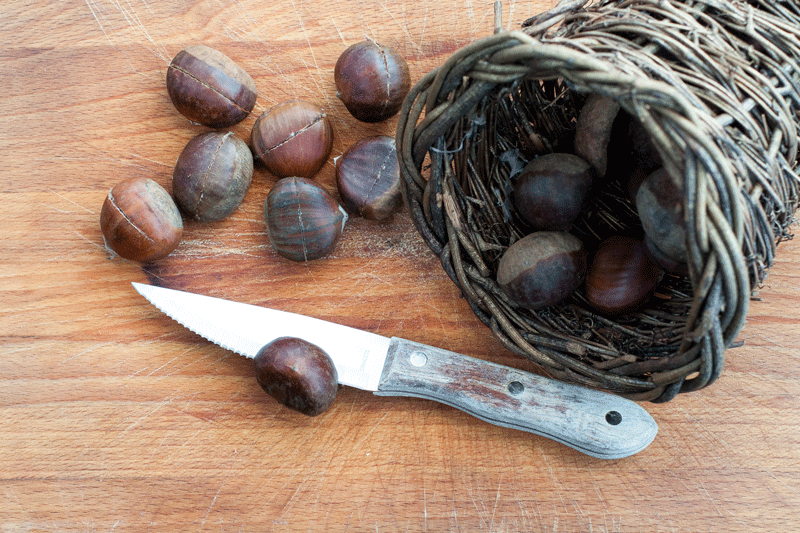
Roasting chestnuts on a fire or grill
- Fire Up the Grill or Open Fire: Ensure the fire is at a medium heat. If using charcoal, let it turn ashy white. If using wood, wait until it burns down to embers.
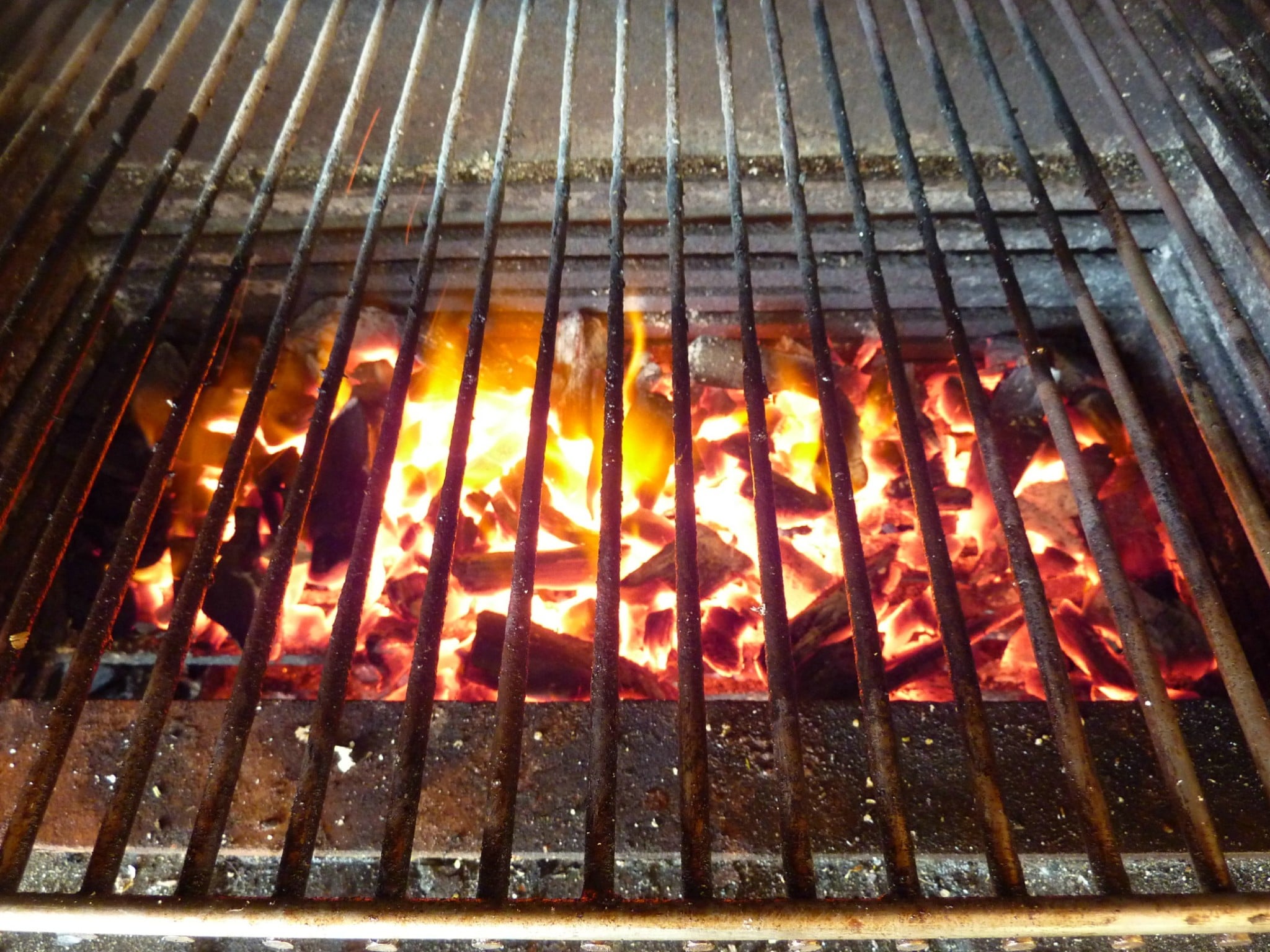
- Equip Yourself: Put on fire-resistant gloves for safety and have long-handled tongs ready.
- Prepare the Roasting Pan: Place the scored chestnuts in a single layer in a chestnut roasting pan or grill basket.
- Place on Heat: Position the roasting pan or grill basket over the fire, ensuring it's not too close to the flames to avoid burning.
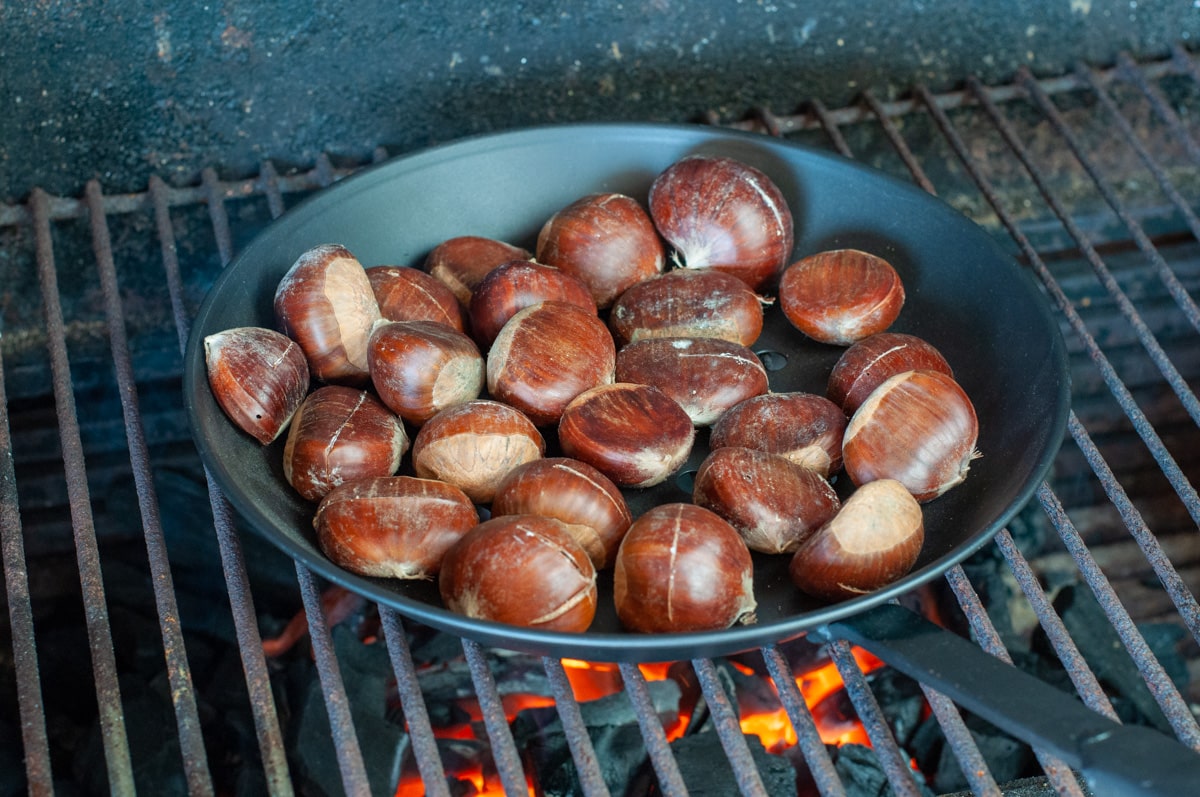
- Turn Regularly: Use the tongs to turn the chestnuts every 2-3 minutes for even roasting.
- Check for Doneness: After 10-15 minutes, the outer shell should have blackened a bit, and the cuts you made should have opened up, revealing the meat of the chestnut.
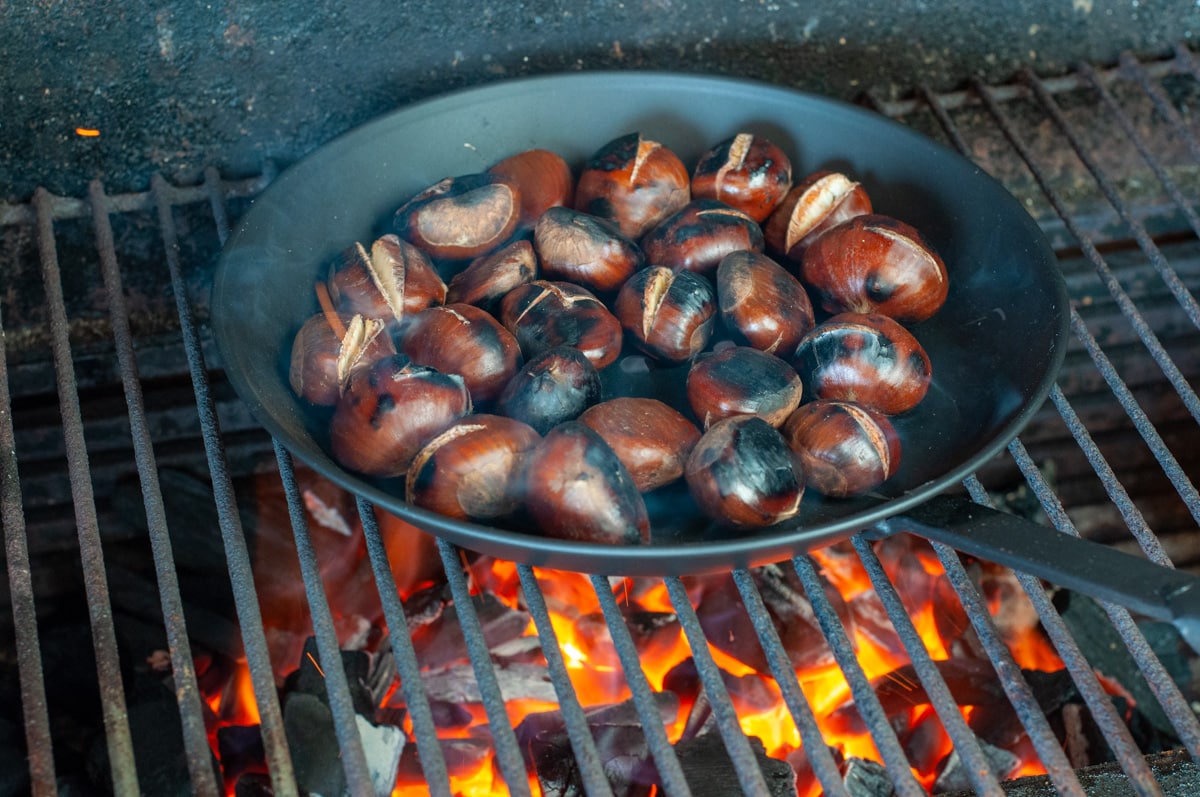
Roasting chestnuts in the oven
- Preheat Oven: Set your oven to 400°F (200°C) and let it preheat.
- Prepare Baking Sheet: Line a baking sheet with parchment paper or aluminum foil for easy cleanup.
- Arrange Chestnuts: Place the scored chestnuts on the baking sheet in a single layer, flat side down.
- Roast: Insert the baking sheet into the preheated oven.
- Time: Roast for 20-25 minutes. Keep an eye on them to prevent burning.
- Turn Once: Halfway through the roasting time, use tongs to turn the chestnuts for even cooking.
- Check for Doneness: The outer shell should have pulled back at the score marks, revealing the meat of the chestnut turning from white to a pale yellow
- Cool Down: Remove from oven and let them cool for a few minutes before serving them.
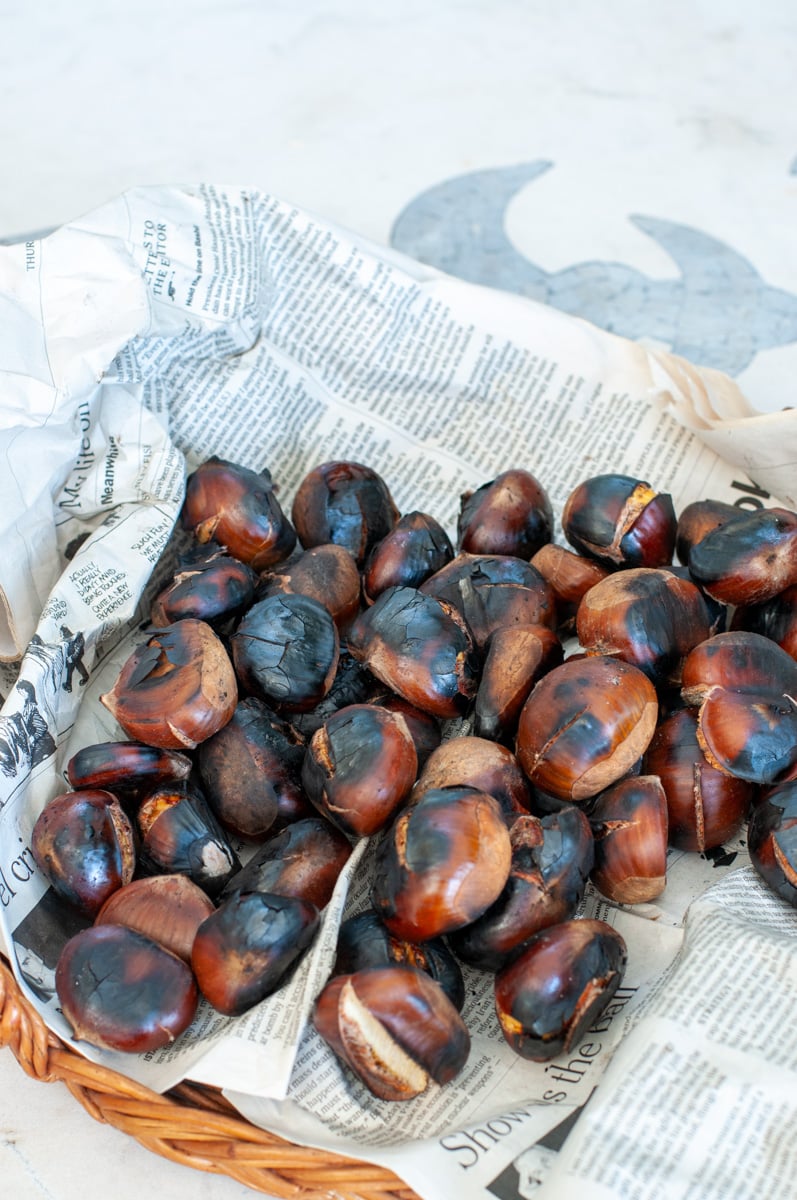
How to serve them
Roasted chestnuts are best enjoyed warm, right out of the oven.
For a rustic touch, serve the cooked chestnuts in a paper bag, cone, or a shallow bowl, allowing guests to peel their own.
If you aim for a more elegant presentation, you can pre-peel the chestnuts and offer them in a decorative dish.
They pair wonderfully with a glass of mulled wine or a warm apple cider.
Roasted chestnuts make a versatile addition to any holiday spread, whether as a snack, appetizer, or even a side dish.
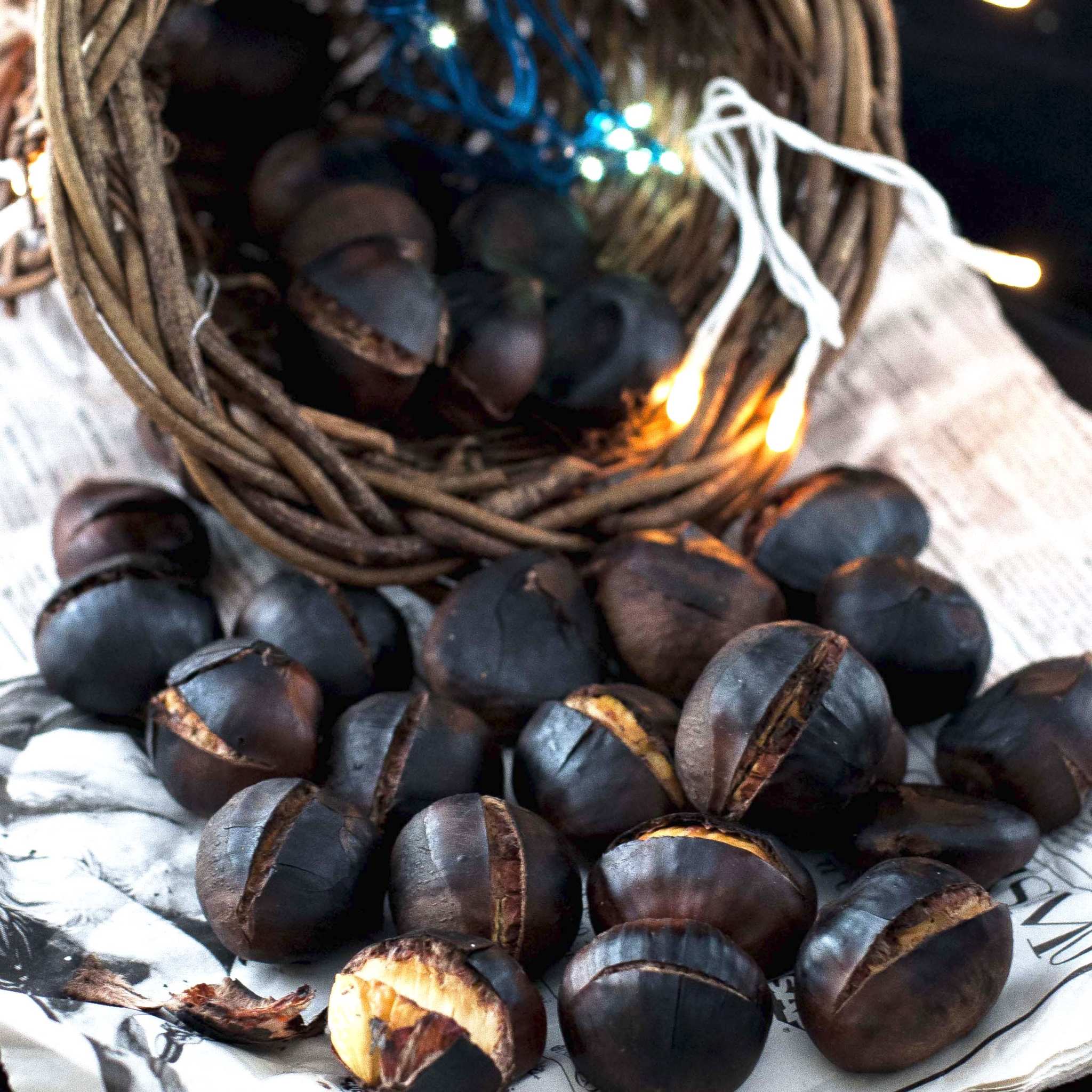
How to peel them
Eating roasted chestnuts is a warm and satisfying experience, perfect for a chilly evening or a festive gathering.
Follow these steps to savor the delicious flavor of roasted chestnuts:
- Cool Them Down: Allow the roasted chestnuts to cool for a few minutes after they come out of the oven or fire. They can be extremely hot when freshly roasted, so be cautious.
- Crack the Hard Shell: To access the tender chestnut meat inside, you'll need to crack the shell and peel them. Hold the chestnut with a clean kitchen towel or oven mitt to protect your hands, and then use your fingers to squeeze the chestnut until the shell cracks open gently.
- Remove the Inner Skin: Once you've cracked the shell, you'll find an inner skin or pellicle covering the chestnut meat. While you can eat the chestnut with the skin on, peeling it off is often easier. To do this, simply pinch the chestnut between your fingers or use a small knife to remove the skin.
- Enjoy: Now that your roasted chestnuts are peeled and ready, take a bite and savor the warm, nutty flavor.
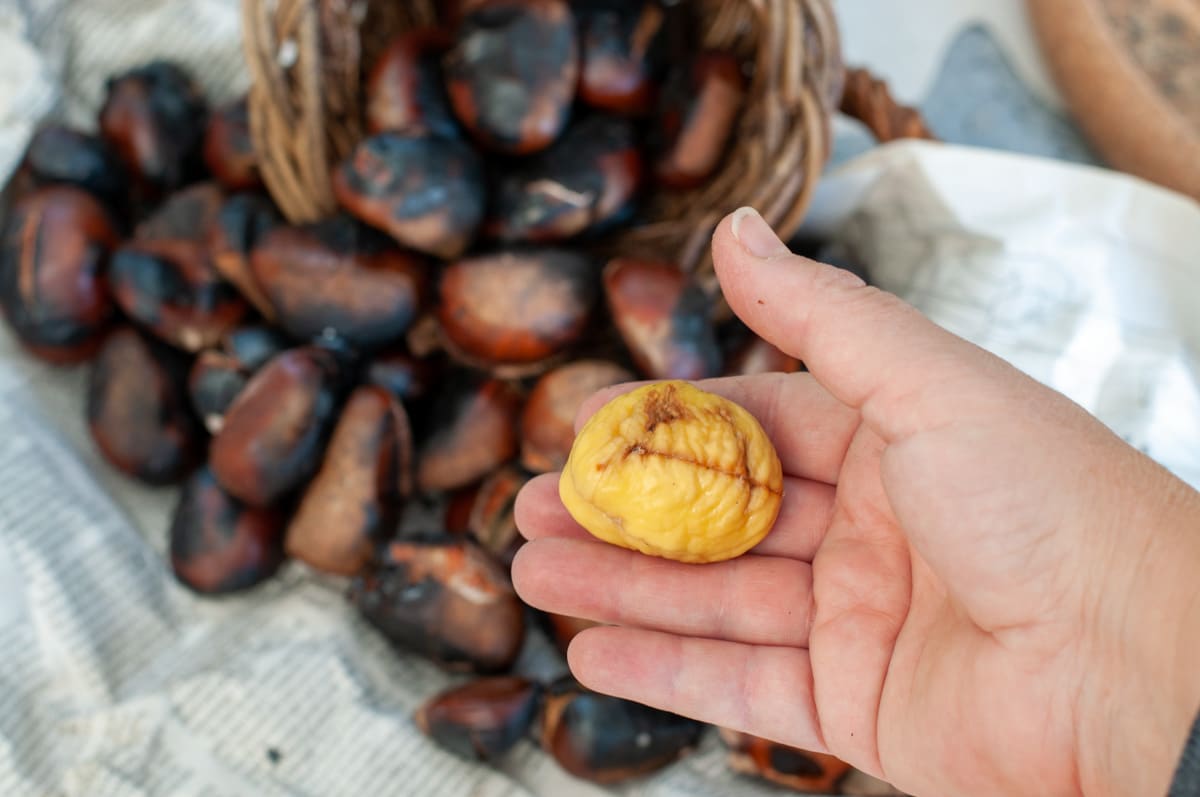
How to eat them
Roasted chestnuts possess a captivating allure akin to that of cherries.
Once you take that initial bite, refraining from indulging further becomes quite the challenge.
I'm not alone in this, as many individuals, like myself, enjoy nibbling on roasted chestnuts while enjoying leisurely activities such as watching television.
Especially if watching a Christmas movie!
Some of us, including me, take pride in assuming the role of the designated "chestnut opener."
It extends beyond mere shell cracking; it becomes a comforting tradition that connects us to the past.
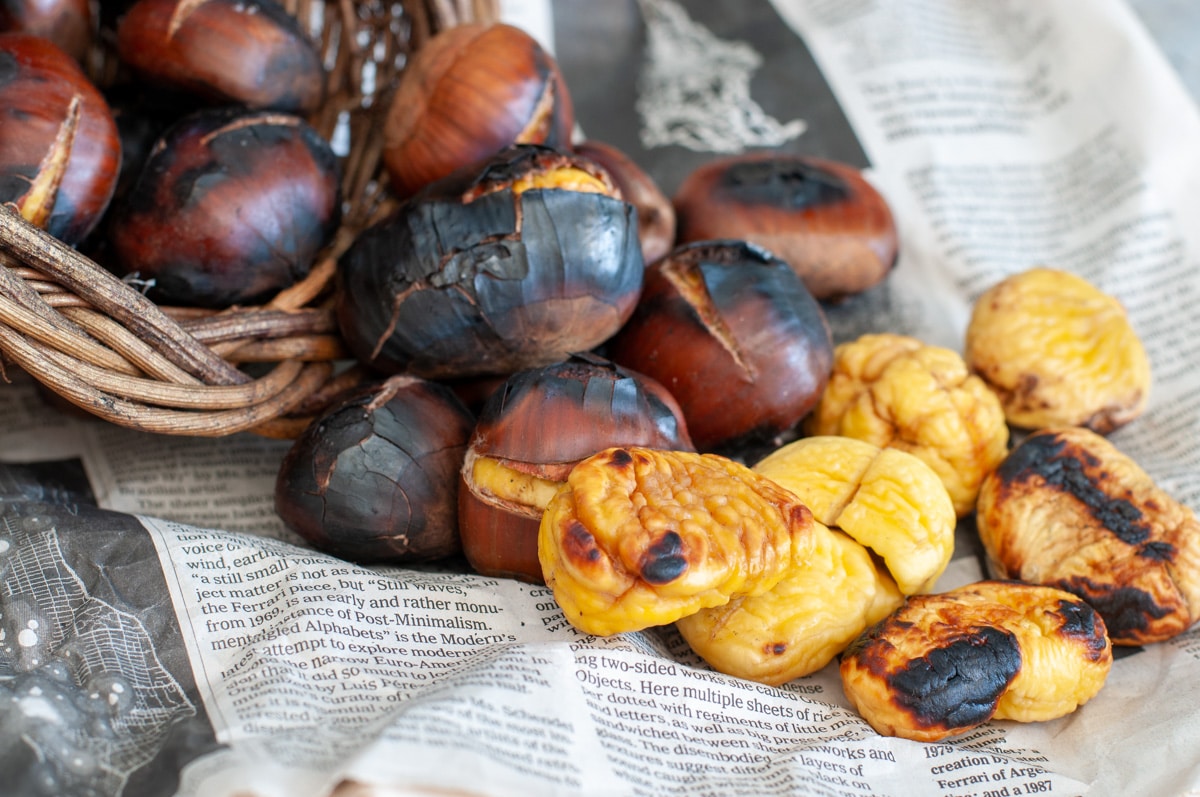
Unpleasant surprises
However, be careful, as sometimes you may find someone inside a roasted chestnut who is already eating it.
It's a good practice to open them up before consumption.
This step ensures that there are no worms and that the chestnut is perfect to enjoy.
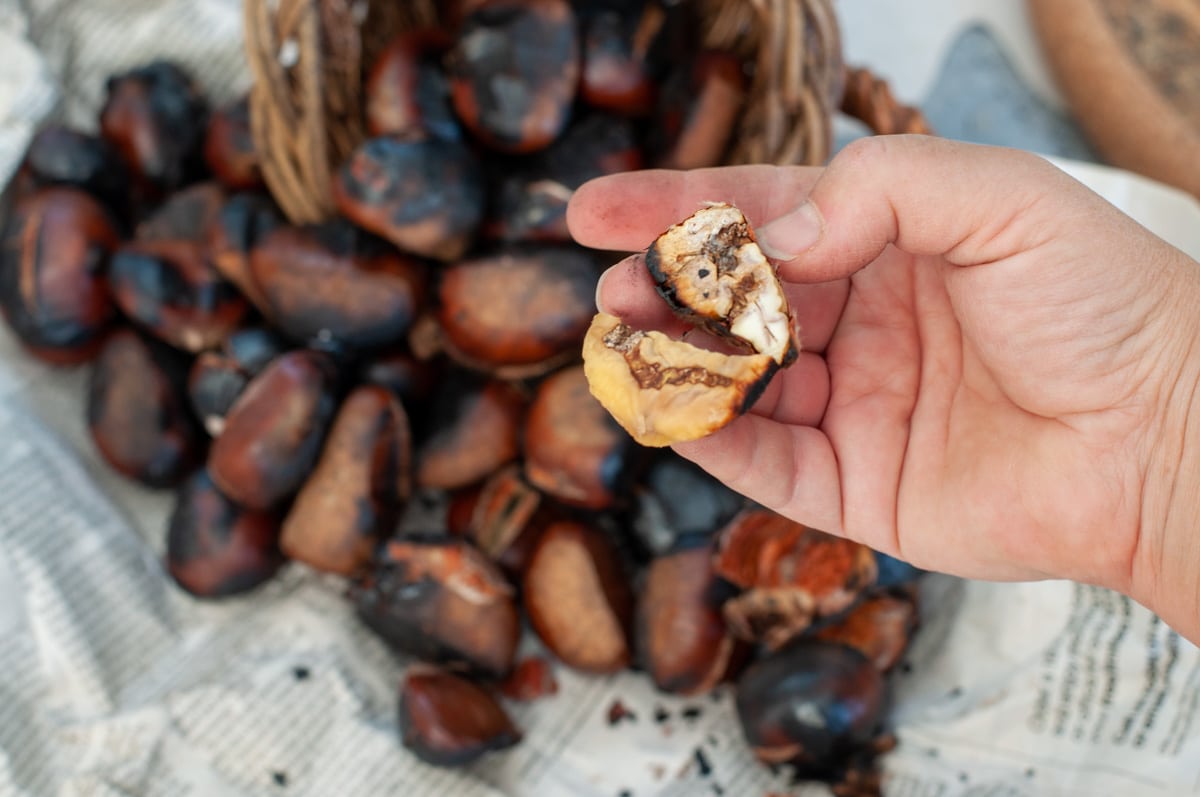
How to store them
After enjoying your freshly roasted chestnuts, if you have any leftovers, proper storage is key to maintaining their flavor and texture.
If you plan to eat them within a day or two, simply place them in an airtight container and store them at room temperature.
For longer storage, refrigerate the chestnuts in a sealed container for up to a week.
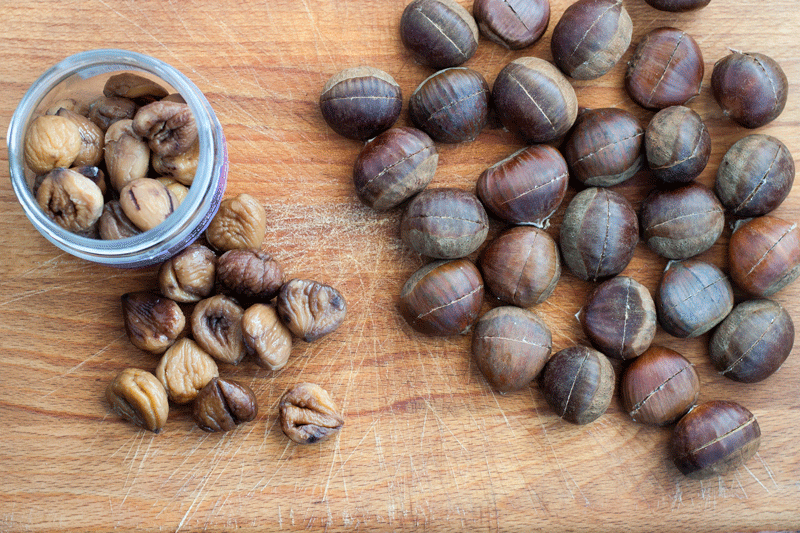
More recipes with chestnuts
More recipes on an open fire
If you are making this Roasted chestnut recipe, leave your comment below I would like to hear from you. You can find more delicious ideas if you FOLLOW ME on Facebook, YouTube, Pinterest and Instagram or sign up to my newsletter.
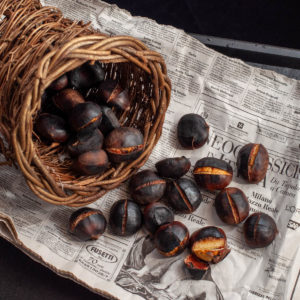
📋Roasted Chestnuts On an Open Fire or Kitchen Oven
Ingredients
- 14 oz fresh chestnuts preferably Marron
- 1 bag charcoal
Instructions
- Prepare the barbecue1 bag charcoal
- Make an intend in the chestnut shells, the chestnuts will expand when roasted14 oz fresh chestnuts
- Place the chestnuts in the chestnut pan with holes
- Cook them on an open fire, barbecue or if you don't have one in a hot oven 420 F - 200C
- Turn them around until all sides are cooked
- When the chestnuts turn into a dark yellow color and the cut opens up, they are ready
- Best to eat them warm, but let them rest for few minutes before trying to open them
Video
Notes
- If I don't have a barbecue, I roast it in a very hot oven.
- If you are roasting the chestnuts you need to make a small indent in the shell and halfway to the pulp otherwise, they will explode when they cook.
- You don't need to indent them if you are boiling them.
- The chestnuts should be cooked in a pan with large holes at the bottom.
Nutrition
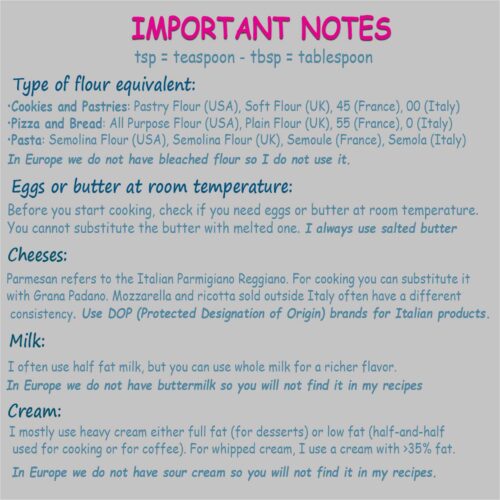

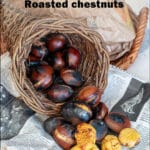
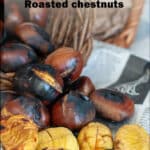
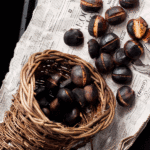
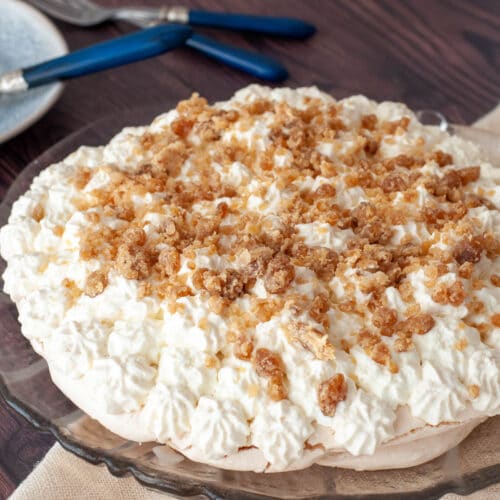
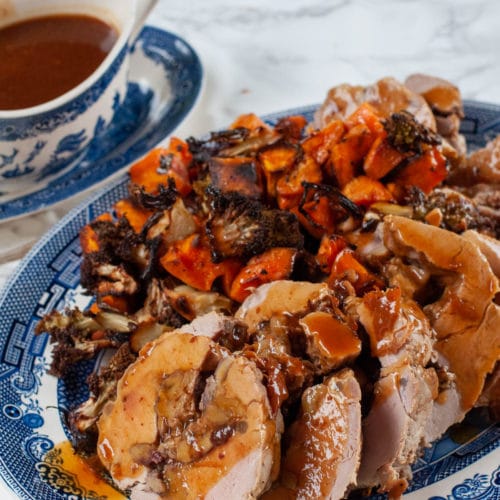
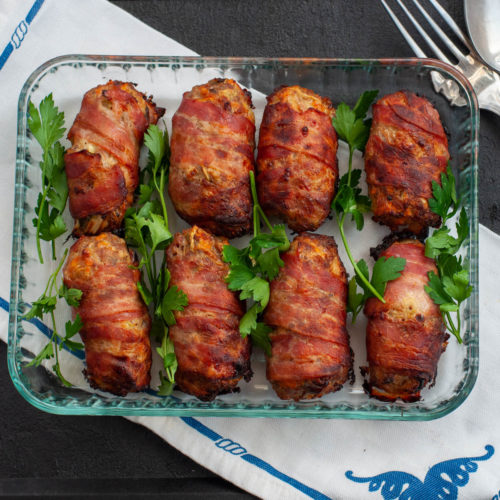
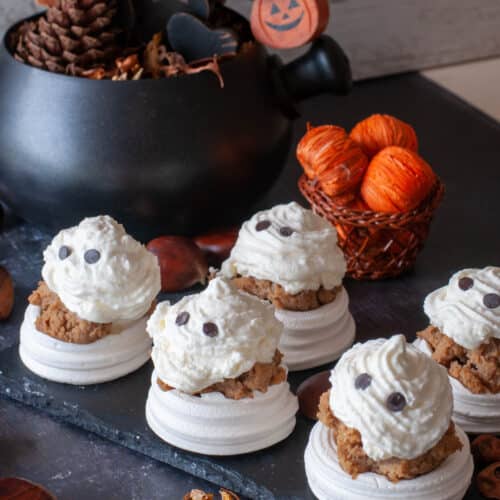
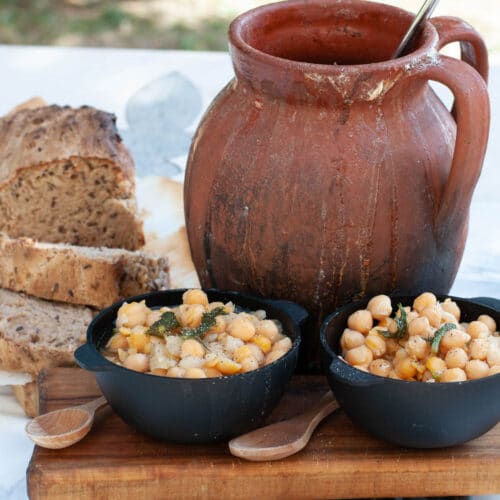
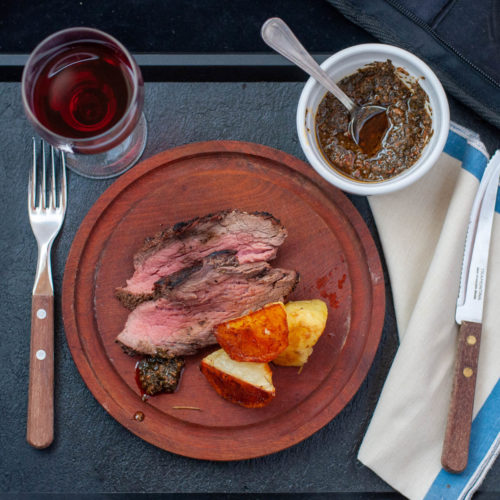
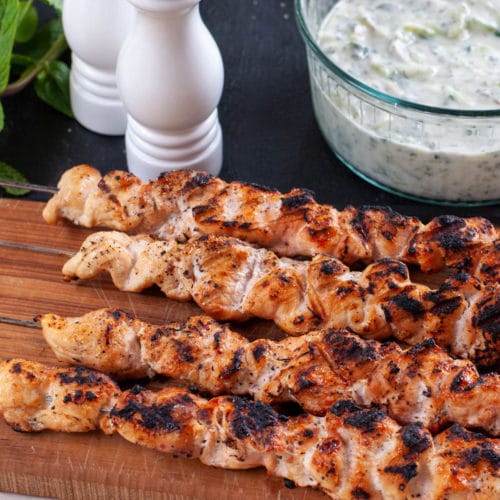
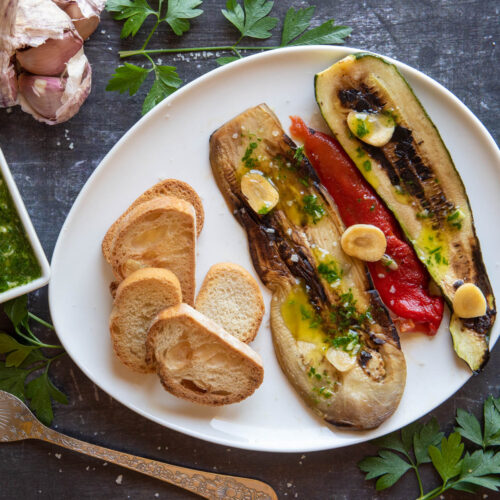

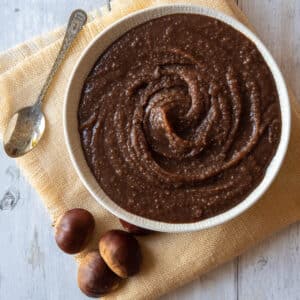
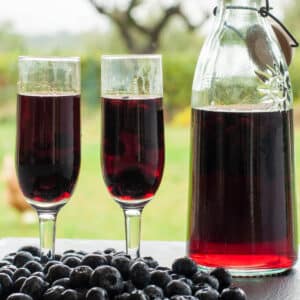
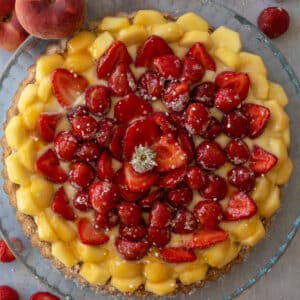
Elaine @ Dishes Delish
Loved this post Laura. Though the worm in a chestnut grosses me out somewhat!! My grandmother used to roast chestnuts and I never once even considered looking for a worm. Eek. These look tasty and I can just imagine noshing on them in-front of the television.
Laura
Oh my Elaine, who knows how many you have eaten. But they probably taste the same as the chestnuts
Beth
I roasted chestnuts one time for a party. I had the worst time getting them out of the shells! I was cutting my fingers, everywhere! How do you avoid that?
Laura
Really? Maybe you should have cooked them longer. They are difficult to open when they are not properly cooked.